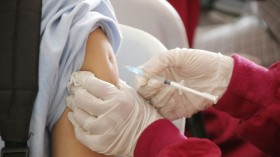Infants, toddlers, and tweens all have different nutritional needs. For humans, motherly intuition certainly helps, but a large part of getting a child what he or she needs comes from doctor recommendations. Bees, however, don't have pediatricians. So how do little larvae get the right nutrition when they need it? A new study investigates.
The study, recently published in the journal Animal Behavior, details how it's a lot more simple than you would imagine.
While no bee truly "talks," they communicate with chemicals, telling one another when there is danger near, where the nest needs tending, and where to forage for pollen.
It's these same chemical signals, called pheromones, that give baby bees an edge over a human's own talkative tot. Unlike in the case of baby babble, nurse bees can understand the signals from larvae pheromones, literally taking the baby's order for the day and bringing them food laden with just the right protein content.
This was determined after researchers took a closer look at how nurse bees handled larvae of various ages and castes. They found that nurses gorge pollen and produce feed for queen larvae with copious amounts of protein and sugar throughout development. However, for worker larvae, nurse bees split this diet into two parts: a young worker receives protein for growth, while older larvae are exclusively fed a diet with a high sugar component to facilitate final development.
However, it was also discovered that that protein-rich diet requires more pollen than a sugar-based diet. That's why when adult worker bees are exposed to the pheromone e-beta ocimene - exclusive to younger larvae - twice as many foragers return to the colony laden with pollen.
Even without actual larvae around, researchers found that the hive will still react to this pheromone, launching into escalated pollen collection.
According to the researchers, taking advantage of this system could even offer bee keepers a new means to boost pollination services - a process essential to fruit and seed production.
© 2024 NatureWorldNews.com All rights reserved. Do not reproduce without permission.



![Retention Ponds, Wetlands Can Decrease Particle Pollution in Aquatic Environment by 75% [Study]](https://1471793142.rsc.cdn77.org/data/thumbs/full/70200/280/157/50/40/retention-ponds-wetlands-can-decrease-particle-pollution-in-aquatic-environment-by-75-study.jpg)

